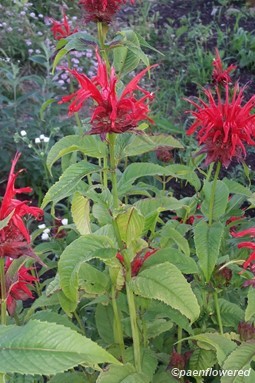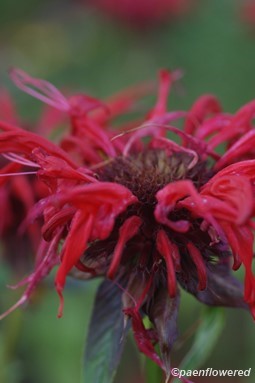Monarda didyma
A scarlet-red summer flower with aromatic foliage
Monarda didyma scarlet beebalm
This native perennial wildflower is one of the most beautiful and brightly colored flowers in our state due to its dense showy cluster of scarlet tubular flowers. It also has red-colored bracts and red-tinted leaves below the flower cluster. Sometimes the upper flower tubes bloom before the lower ones giving the whole flower cluster with red bracts a temporary appearance of being two-layered.
Each tubular flower is about 1½ inches long and has a protruding red-tipped stigma and yellowish anthers coming out the tube. The edge of the flower tube has an arching upper lip and a spreading, three-lobed lower lip. The edge has five teeth with hair-like tips. The red color tends to attract hummingbirds and butterflies as pollinators, but in spite of its common name, bumblebees and not short-tongued bees are the primary pollinators.
The name beebalm is said to come from the use of an extract from the plant that was traditionally used to heal and soothe injuries, including bee stings. This is more likely to be the origin of its common name. The leaves can be used to season meat. Though a bit bitter, the taste is like a combination of mint and oregano. The plant has a long history of medicinal use. The crushed leaves exude fragrant oil.
After pollination the flower is replaced by 4 ovoid nutlets. The flowers have no fragrance, but the foliage is aromatic. The plant may also form colonies by the growth of rhizomes. The plant grows two to five feet high and blooms from July to September. Scarlet beebalm has a square stem like all mints, and has three to 6 inch long paired leaves with short stalks.
The plant is known to contain the antiseptic thymol, commonly used in modern mouthwashes. Scarlet beebalm has been extensively cultivated into gardens, often outside its natural range, and has escaped cultivation in these places. It is also considered a good companion plant for tomato gardens, protecting the tomato against disease and improving its taste. Unlike other types of mints it is not especially aggressive in spreading to dominate a garden. This species, however, is prone to powdery mildew when it grows in damp places with high humidity.
Habitat & Range
Frequent in moist woods, creek and stream banks, also cultivated. Prefers sun or part shade and rich, moist, humusy soil.
Present throughout the state.
Range: Native from southeastern Canada and the northeastern United States, west to Minnesota and south through the Appalachian Mountains to Georgia and Missouri.
| EMP: | FAC |
|---|---|
| NCNE: | FACU |
Phenology
Flowers July to September. Blooming period is 6 to 8 weeks.
Characteristics
Inflorescence terminal tuft, 1 flower head per tuft; heads supported by whorl of showy, red-tinged, leafy bracts; flower head 2 to 4″ across
Flowers bright red, tubular, two-lipped; upper lip arching, lower lip spreading, 3-lobed; 2 sterile & 2 fertile stamens; 1½″ long
Leaves simple, opposite; ovate to nearly ovate-lanceolate, large, dark green and sometimes red-tinted; serrated margins, accuminate, rounded at base; minty aroma when crushed
Stems square (4-sided), glabrous to sparsely pubescent, especially at the nodes
Fruit 4 brown, ovoid, dry and indehiscent nutlets per flower, enclosed into a persistent calyx; 1 seed per nutlet
Height 2-4½ feet; spread 2 to 4 feet
Plant Codes
S-rank: S5 (Secure)
G-rank: G5 (Secure)
Ecology
Hummingbirds, swallowtails, and bumblebees flock to the nectar-rich blooms.
Minty foliage deters most deer and rabbits, though some moths feed on the leaves.













Comments
Have you spotted this plant in your area? We'd love to hear about your experience! Share your comments or questions about the plant below. Comments are moderated before posting.